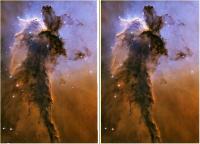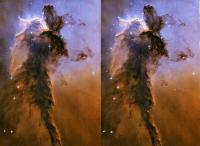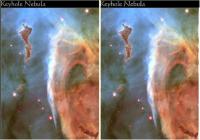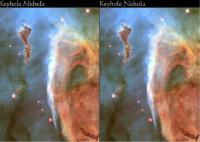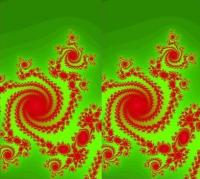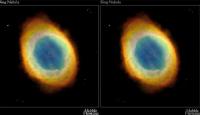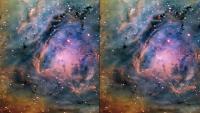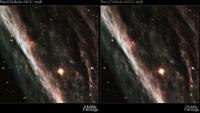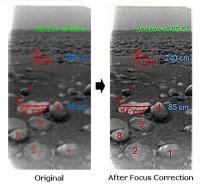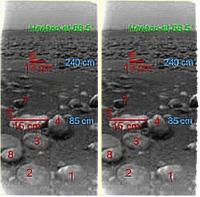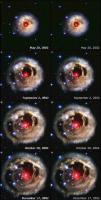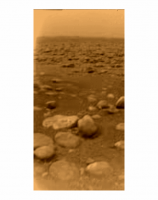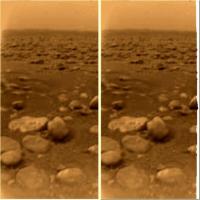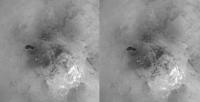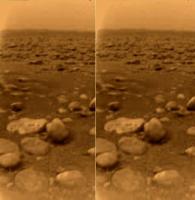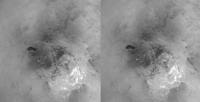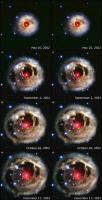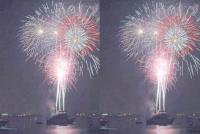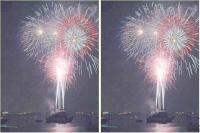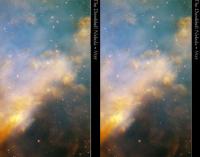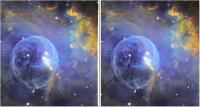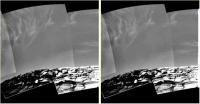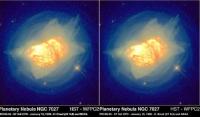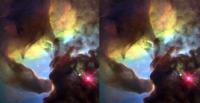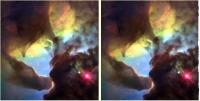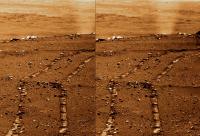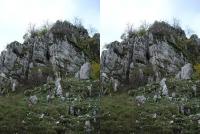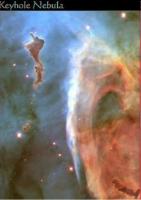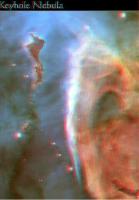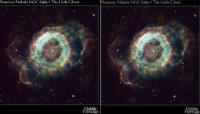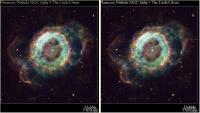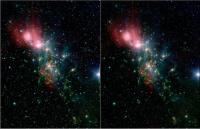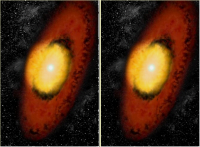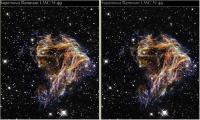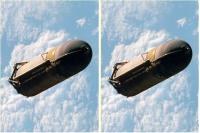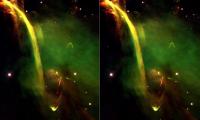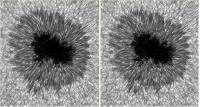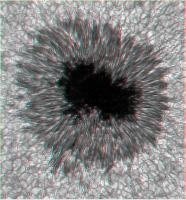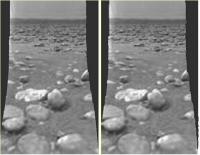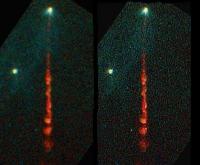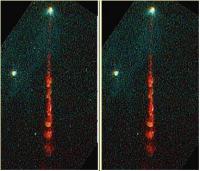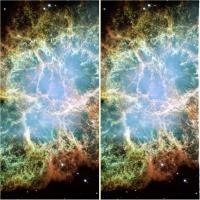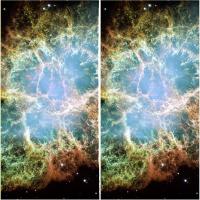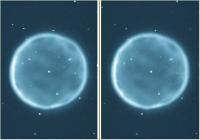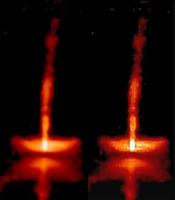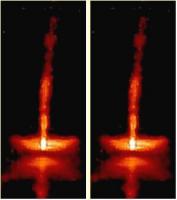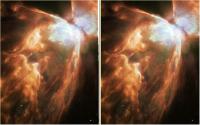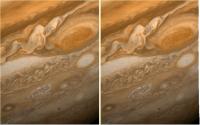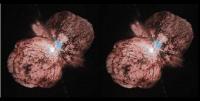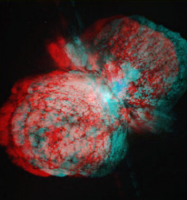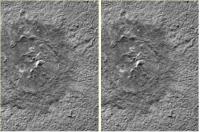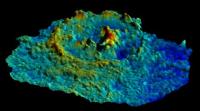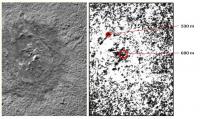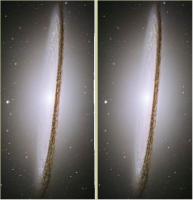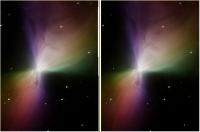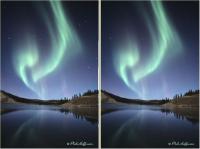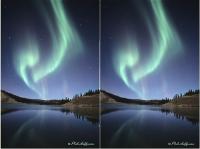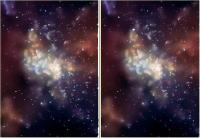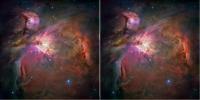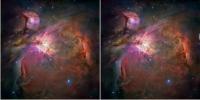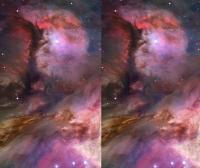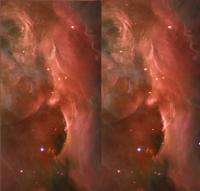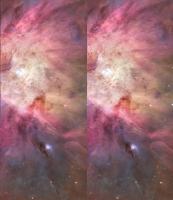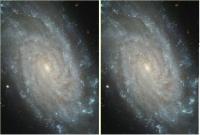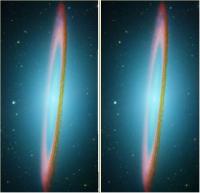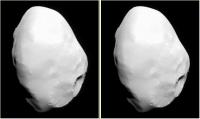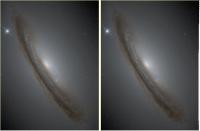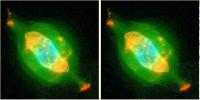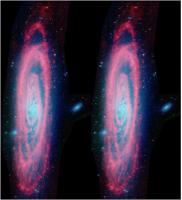Printable Version of Topic
Click here to view this topic in its original format
Unmanned Spaceflight.com _ Telescopic Observations _ Stereograph Of Nebula
Posted by: Harry Oct 23 2005, 10:53 AM
The following pictures are the synthesized stereographs for Eagle Nebula (originally taken by HST). Please view them with parallel eyes or crossed eyes.
For other planetary stereographs, visit;
http://139.134.5.123/tiddler2/stereographer/gallery/nebula/nebula.htm
Posted by: malgar Oct 23 2005, 05:35 PM
Hi Harry, I like very much your 3D works. I would like to visit the page that explains how to do that but it doesn't work.. ![]()
How can I view this page?
http://139.134.5.123/tiddler2/stereographer/stereograph.htm
Bye,
Ale.
Posted by: dilo Oct 23 2005, 08:44 PM
Ciao, Malgar ![]() . Some stereograms are really stunning and I'm intrigued by the method... congratulations, Harry!
. Some stereograms are really stunning and I'm intrigued by the method... congratulations, Harry!
About link malfunction, using windows, I'm able to see the page in the link, even if I'm required to insert my email adress in order to avoid spam (and t hen appear a "Comment/Enquiry Form" to be filled).
However, also in the link no clear explaination is done about method to extract/assign depth information... even if not said, visualization method should be "parallel eyes" but this limits images sizes! ![]()
I do not easily visualize parallel eyes stereograms and I prefere crossed-eys... using this technique, nebulae/galaxies are realistic because luminous (closest) stars appear in the foreground. So I suspect they are wrongly showed in background in the original "parallel eyes" version... Harry, is possible to correct it?
Posted by: Harry Oct 24 2005, 01:48 AM
How can I view this page?
http://139.134.5.123/tiddler2/stereographer/stereograph.htm
Bye,
Ale.
Oh, sorry. Probably some Javascript checker had worked on your browser when visiting my website. Is it available to make that checker off temporally?
Posted by: Harry Oct 24 2005, 02:28 AM
About link malfunction, using windows, I'm able to see the page in the link, even if I'm required to insert my email adress in order to avoid spam (and t hen appear a "Comment/Enquiry Form" to be filled).
However, also in the link no clear explaination is done about method to extract/assign depth information... even if not said, visualization method should be "parallel eyes" but this limits images sizes!
I do not easily visualize parallel eyes stereograms and I prefere crossed-eys... using this technique, nebulae/galaxies are realistic because luminous (closest) stars appear in the foreground. So I suspect they are wrongly showed in background in the original "parallel eyes" version... Harry, is possible to correct it?
Probably the lack of explanations has made visitors confuse. Surely I didn't mentioned whether "parallel eyes" or "crossed eyes" should be applied for in the website. Actually some of pictures in the attached gallery are for "parallel eyes" and some others are for "crossed eyes"! I should have noted which method is applied for each pictures...
By the way I attached another synthesized stereographs (software: http://139.134.5.123/tiddler2/stereographer/stereograph.htm, focus depth:=2, slide level:=3). Please view them with parallel eyes or crossed eyes you prefer.
Posted by: Bob Shaw Oct 24 2005, 09:12 PM
Harry:
I can do free-view cross-eyed quite easily, I need a viewer for the parallel chaps though!
I looked at your website, but I have to say that I'm slightly at a loss as to how images at infinity can be turned into such effective 3D representations. The nebulae images look really, er, real, yet the information required for them to be real images is plainly unavailable to us.
You've not got a Police Box parked in the street, have you?
Bob Shaw
Posted by: dilo Oct 24 2005, 09:37 PM
By the way I attached another synthesized stereograph. Do you see it with parallel eyes or crossed eyes? (for me it is better or realistic to see it with parallel eyes.)
I tried both methods...
Also for this image, I prefere crossed eyes view for two reasons, both already mentioned: 1) Stars look closer than Horse nebula, as they should; 2) I'm not confortable with parallel eyes method, and I cannot perfectly focus in this way
Generally speaking, parallel eyes give the sensation to see an infinitely distant object (which is a clear benefit for these astronomical subjects) but have a great handicap related to the small images dimensions needed to see it (distance between images centers shouldn't exceed inter-ocular spacing, in fact I had to rescale them on the screen of my monitor..).
I suggest you to split your beatiful gallery in two sections, based on the method to be used.
Anyway, we all are asking the same thing to you: how did you extracted so "realistic" and detailed depth informations from original images???
The result is so amazing that I'm seriously thinking some kind of magic!
Posted by: ElkGroveDan Oct 24 2005, 11:09 PM
I'm waiting for the analglyph.....
Posted by: dilo Oct 25 2005, 01:45 AM
Hope Harry do not mind if I post this "anaglyphed" version of one stereogram:
Posted by: Harry Oct 26 2005, 02:06 AM
Also for this image, I prefere crossed eyes view for two reasons, both already mentioned: 1) Stars look closer than Horse nebula, as they should; 2) I'm not confortable with parallel eyes method, and I cannot perfectly focus in this way
Generally speaking, parallel eyes give the sensation to see an infinitely distant object (which is a clear benefit for these astronomical subjects) but have a great handicap related to the small images dimensions needed to see it (distance between images centers shouldn't exceed inter-ocular spacing, in fact I had to rescale them on the screen of my monitor..).
I suggest you to split your beatiful gallery in two sections, based on the method to be used.
Anyway, we all are asking the same thing to you: how did you extracted so "realistic" and detailed depth informations from original images???
The result is so amazing that I'm seriously thinking some kind of magic!
I found some people prefer crossed eyes view and some other people don't. So I think I should prepare two types of stereograph, then he or she can choose parallel eyes view or crossed eyes view which he or she prefer. I modified previous my posts by adding stereographs for different viewing method.
The method I employed is for detecting the deviation from focal point on each spot of the original picture (for detail of that method, please visit: http://139.134.5.123/tiddler2/c22508/focus.htm.) However it can not distinguish whether that deviation is in front of or behind the focal point. Therefore the viewing method (i.e. parallel eyes or crossed eyes) applied for the stereograph depends on whether the focal point is in the foreground or background of original picture. That's why the stereographs for parallel eyes and crossed eyes are mixed promiscuously in my gallery. Following your suggestion, I'll modify my gallery by adding stereographs for different viewing method.
Posted by: Harry Oct 26 2005, 02:27 AM
Nice anaglyph! I also have made the program for creating anaglyph, but yours is quite better than mine.
The following stereographs are for the part of Keyhole Nebula. Please view them with parallel eyes or crossed eyes you prefer.
Posted by: Harry Oct 27 2005, 11:19 AM
Perhaps someone may think measuring the deviation from focal point is meaningless for astronomical objects since their focal length from telescope is regarded as infinity. However as shown in the following stereographs of clouds on earth synthesized by http://139.134.5.123/tiddler2/stereographer/stereograph.htm (please view them with parallel eyes or crossed eyes which you prefer), we can see those clouds perspectively even their focal length is almost infinity for our eyes. Namely our eyes are thought to recognize 3-dimensional feature of object without perceiving the difference of geometrical focal length.
Also I attached the synthesized stereographs of Orion Nebula (please view them with parallel eyes or crossed eyes which you prefer.)
Posted by: Harry Oct 28 2005, 09:25 AM
The following images are the stereograph for Orionis Nebula. The original image was taken by HST.
(view: parallel eyes)
Posted by: Bob Shaw Oct 28 2005, 10:38 PM
Also I attached the synthesized stereographs of Orion Nebula (please view them with parallel eyes or crossed eyes which you prefer.)
Harry:
I've (oddly enough) wanted to make 3D images of clouds for years, but I confess that the only methods I could come up with involved several cameras at different locations. I can't for the life of me see how real stereo images can be generated from (in Terrestrial terms) any objects which are within the hyperfocal distance(s) of a single image taken with one lens. By definition, they are are on one plane!
It may be that physiological tricks can be played with images which will persuade us that depth is present, but I don't think that they represent the actual 3D structures, however interesting the results appear!
Bob Shaw
Posted by: Rob Pinnegar Oct 29 2005, 05:32 AM
There's no way we can get _real_ stereo images, of course. My gut-instinct guess is that the closest we could get would probably be Proxima Centauri and Alpha Centauri A/B, using photos taken over the course of several years. Even for this example, though, the mutual revolution of A and B during the time lapse between images would probably spoil the effect (unless we waited exactly one A/B orbital period).
However, it should be possible to manipulate images to artifically incorporate information about distance, by moving pixels around. That's probably what is being done here.
Posted by: Harry Oct 29 2005, 07:43 AM
Bob Shaw
Thank you. The method I employed is based on a mathematical prospect rather than physiological. As shown in the following stereograph synthesized by http://139.134.5.123/tiddler2/stereographer/stereograph.htm, we can see the Julia set (it is a kind of fractal figure) in perspective. If we see the Julia set with a diameter of one mile drawn on a plane from the place ten miles away, it must be seen in perspective. They say many objects in the natural world (shoreline, mountain ranges, etc.) have fractal figures. So I thought we grasp the 3-dimensional feature of clouds with the same principle.
Posted by: Harry Oct 29 2005, 08:27 AM
However, it should be possible to manipulate images to artifically incorporate information about distance, by moving pixels around. That's probably what is being done here.
If our left eye were one light year away from right eye, then we would have easily seen those stars in perspective...
Yes, the displacement of pixel depends on the deviation from focal point on each spot. However I must confess in the case of stars my software hardly estimates the correct deviation. Therefore even if using my software, Proxima Centauri and Alpha Centauri A/B will not be seen in perspective.
The following stereograph synthesized by http://139.134.5.123/tiddler2/stereographer/stereograph.htm is for Ring Nebula (view: parallel eyes). It seems to have egg-shape rather than "ring".
Posted by: jamescanvin Oct 29 2005, 11:58 PM
Which of course is probably close to reality (rings like this are nearly always spherical(ish) shells) but that must be a coincidence right? Your not guessing the 3D structure before making these images are you; just running a mathematical routine?
James
Posted by: Harry Oct 30 2005, 03:55 AM
James
Of course I don't have any idea about the 3-dimensional shape of nebula before running the software (I think no one knows it!) Regarding the pictures shown in my previous posts, I've never modified those pictures with sharpening or color enhancing before and after applying http://139.134.5.123/tiddler2/stereographer/stereograph.htm for them.
The following picture is the stereograph for Lagoon Nebula (view: parallel eyes).
Posted by: dilo Oct 30 2005, 07:25 AM
Wath beauties, I'm increasingly delighted by these stereograph, Harry, indipendently from their real accuracy!
It seems that program decide automatically the depth structure, I'm right?
Posted by: malgar Oct 30 2005, 06:45 PM
Hey Harry, why don't you try it on Titan surface image? ![]()
http://photojournal.jpl.nasa.gov/jpeg/PIA07232.jpg
Posted by: Harry Oct 31 2005, 12:19 AM
It seems that program decide automatically the depth structure, I'm right?
Yes. As explained in the site http://139.134.5.123/tiddler2/stereographer/stereograph.htm, my method estimates the deviation from focal point on each spot of the image by evaluating the extent of blurry. Of course for telescope the focal length of any astronomical object is regarded as infinity. However if that object has fractal appearance, it is possible to estimate the deviation from focal point (i.e. infinitely remote place) with the similar manner.
The following picture is the stereograph for Pencil Nebula (view: parallel eyes.) By the way, if available, could you show us other anaglyphs? For, I was so impressed by the anaglyph you've made.
Posted by: Harry Oct 31 2005, 12:34 AM
http://photojournal.jpl.nasa.gov/jpeg/PIA07232.jpg
OK. But the image you've indicated is not the original image. My software doesn't work well for any reprocessed image. You can see the original image http://www.esa.int/SPECIALS/Cassini-Huygens/SEMC8Q71Y3E_1.html#subhead1.
I de-convoluted the original image with http://139.134.5.123/tiddler2/c22508/focus.htm and synthesized stereograph based on that de-convoluted image. In the attached pictures, the first one is the result of de-convolution and the second one is its stereograph.
Posted by: Harry Nov 1 2005, 06:08 AM
Stereoscopic V838 Monocerotis synthesized by http://139.134.5.123/tiddler2/stereographer/stereograph.htm (view: parallel eyes)
Posted by: dilo Nov 1 2005, 12:21 PM
Harry, I think Malgar was referring to the version without the disturbing text. I strongly reccomend to use the color image reported in the same link (is a lossless png) or, if you prefere, my contrast enhanced version:
About anaglyph, here I worked out the last post from you. Anyway, you can easily do by yourself using Anabuilder free software:
http://anabuilder.free.fr/welcomeEN.html
Anyway, I suggest you to make bigger stereograms, because is possible to visualize them using crossed eyes or anaglyphs and results should be even more impressive!
Posted by: Harry Nov 1 2005, 02:11 PM
Thank you for that anaglyph and letting know me the website for making the anaglyph. I attached the stereograph based on the image you've posted. Also I attached another stereograph for Titan. It is the image of Titan's south polar region.
Posted by: dilo Nov 1 2005, 05:54 PM
Pls, can you make always also crossed eyes version?
Otherwise me (and others too, I believe) cannot immediately/easily visualize your beautiful stereograms...
Now I hope to see also bigger images, Harry!
Posted by: Harry Nov 2 2005, 09:38 AM
Otherwise me (and others too, I believe) cannot immediately/easily visualize your beautiful stereograms...
Now I hope to see also bigger images, Harry!
OK, I'll convert the above two stereographs for crossed eyes. Besides I posted the stereograph of ITOKAWA for parallel/crossed eyes to http://www.unmannedspaceflight.com/index.php?showtopic=870
Posted by: Bob Shaw Nov 2 2005, 10:41 PM
Harry:
I see the stars as being in the foreground, but suspect they should be in the background...
Bob Shaw
Posted by: Harry Nov 3 2005, 11:15 AM
The following stereographs are for Titan's landscape, Titan's south polar region (view: crossed eyes), and Nebula IC4406 (view: parallel/crossed eyes) synthesized by http://139.134.5.123/tiddler2/stereographer/stereograph.htm.
Posted by: Harry Nov 3 2005, 11:52 AM
I see the stars as being in the foreground, but suspect they should be in the background...
Bob Shaw
Is that so? That stereograph is for parallel eyes view. Did you look at it focusing behind the screen? Anyway as replying to the question from Rob, I must again confess the perspective appearance among stars in my stereographs is not reliable since the blurry of star appeared on the image doesn't reflect the distance of that star from the telescope (If it were, we've had the distance of star from earth without the red-shift calibration!)
The attached stereographs are for NGC6543 (Cat's Eye Nebula / view: parallel/crossed eyes).
Posted by: alan Nov 3 2005, 03:44 PM
I think I know how it could be done. In a nebula the more distant features will be blurred by the dust in front of them. The software may interpret this as distance.
Posted by: Bob Shaw Nov 3 2005, 04:21 PM
The attached stereographs are for NGC6543 (Cat's Eye Nebula / view: parallel/crossed eyes).
Harry:
Parallel = in front
Cross-eyed = behind
Whaddyaknow!
Bob Shaw
Posted by: Harry Nov 4 2005, 12:10 PM
Okeydokey. I'll put the stereograph of V838 for another viewing method. Also please look at dilo's wonderful anaglyph for V838 shown in his earlier post.
Posted by: Harry Nov 4 2005, 12:33 PM
That's right. However since the scattering of light is influenced by the thickness of dusts, the star in the thicker dusts will look further distant. That problem should be resolved for realizing more consistent perspective.
The attached stereograph is for M20. (view: parallel/crossed eyes)
Posted by: dilo Nov 4 2005, 06:00 PM
I like IC4406 and Cat's Eye Nebula, it seems that this algorithm is tailored for nebulae rendering!
Posted by: Harry Nov 5 2005, 11:21 AM
Thank you. In the case of Nebulae, http://139.134.5.123/tiddler2/stereographer/stereograph.htm synthesizes the images for eyes as if the left eye is 1000 light years away from the right eye. The following image is the synthesized stereograph for the firework (view: parallel/crossed eyes). You can see the original picture http://en.wikipedia.org/wiki/Firework (gamma correction has been applied.) In this case the left eye was assumed around 50 m away from the right eye. But please mind we can see firework in perspective even though our left eye is not 50 m away from right eye. The software expresses the perspective keeping reality but with the different way from that our eyes employ.
Posted by: CosmicRocker Nov 6 2005, 05:21 AM
This discussion has caught my attention. How could software take a flat image and create a steropair with apparent 3D properties? I don't know the answer, but the fireworks pair gives us the opportunity to view a scene containing other visual cues about the distance to objects that are more familiar to us. I played with the fireworks pair tonight, and I wonder if the program may be doing something as simple as shifting pixel locations according to their relative luminosity. While the sterograph did display apparent depth, some of the parts did not seem to be in the appropriate places.
It might be interesting to use this program to create other, earthly scenes that we could analyze.
Posted by: Harry Nov 6 2005, 12:00 PM
It might be interesting to use this program to create other, earthly scenes that we could analyze.
Ok. I attached the stereograph synthesized by http://139.134.5.123/tiddler2/stereographer/stereograph.htm for an earthly scene (view: parallel eyes.) My method evaluates the extent of blurry or complexity, not brightness nor luminosity for expressing perspective. However if the original picture has halation, the brightness would seem to give some effects on the expressed perspective.
For other "earthly" examples, please visit;
http://139.134.5.123/tiddler2/stereographer/gallery/microscope/microscope.htm (microscopic images / view: parallel eyes)
http://www.geocities.com/q17320508/stereograph/xray2/xray.htm (X-ray images /view: crossed eyes)
http://www.geocities.com/q17320508/stereograph/misc/misc.htm (portraits / view: parallel eyes)
Posted by: Harry Nov 7 2005, 10:51 AM
Stereoscopic M27 (view: parallel eyes) synthesized by http://139.134.5.123/tiddler2/stereographer/stereograph.htm
Posted by: dilo Nov 7 2005, 11:04 PM
Harry, I think this could be another great subject (bubble nebula):
http://antwrp.gsfc.nasa.gov/apod/image/0511/bubble_croman_big.jpg
But pls, again, can you post also bigger (possibly crossed eye) stereograms?
Thanks.
Posted by: CosmicRocker Nov 8 2005, 02:43 AM
Thank you for your explanation, Harry. After reading all the previous posts in this discussion, I still didn't realize the application was shifting pixels according to blurriness. Now, I understand.
I enjoyed your nebulae examples. I think I'll download a copy and try it myself.
Posted by: Harry Nov 8 2005, 01:24 PM
http://antwrp.gsfc.nasa.gov/apod/image/0511/bubble_croman_big.jpg
But pls, again, can you post also bigger (possibly crossed eye) stereograms?
Thanks.
Oh, that's terrific picture! I've made the stereograph for it, but... I found Mr. R. Croman has the copyright of that picture. So I must ask his permission for releasing the stereograph based on his picture. If I got his permission, I'll let you know.
Posted by: Harry Nov 8 2005, 01:50 PM
I enjoyed your nebulae examples. I think I'll download a copy and try it myself.
It's my pleasure that you've enjoyed those stereoscopic nebula images. The software includes http://139.134.5.123/tiddler2/c22508/focus.htm and http://139.134.5.123/tiddler2/contourer/contourer.htm?custom other than Stereographer. Regarding the trial version of Stereographer, you must look at the synthesized stereograph with crossed eyes (or parallel eyes) when the focus on the original picture resides in the background (or foreground.) Within a few days, I'll update the latest version of Stereographer on which you can choose the method to synthesize stereograph for crossed eyes or parallel eyes regardless with the position of focus on the original picture.
The attached stereograph is for M17 (view: parallel/crossed eyes).
Posted by: Astrophil Nov 8 2005, 05:29 PM
Ouch. That really would be quite a hangover.
Posted by: Harry Nov 9 2005, 11:27 AM
^^;
Posted by: Harry Nov 9 2005, 11:58 AM
Stereoscopic M17 (view: parallel/crossed eyes) synthesized by http://139.134.5.123/tiddler2/stereographer/stereograph.htm.
The trial version of http://139.134.5.123/tiddler2/stereographer/stereograph.htm has been updated. It can make stereographs for both parallel/crossed eyes viewers no matter whether the focal point is in the foreground or background.
Posted by: Harry Nov 10 2005, 01:57 PM
http://antwrp.gsfc.nasa.gov/apod/image/0511/bubble_croman_big.jpg
But pls, again, can you post also bigger (possibly crossed eye) stereograms?
Thanks.
Fortunately I could get Mr. R. Croman's permission (Thank you, Russ!) The attached stereographs (view: parallel/crossed eyes) are based on his photo (http://www.rc-astro.com). Do you feel those stereographs too big to see stereoscopically? Then please visit http://www.geocities.com/q17320508/stereograph/planetary7/planetary7.htm. You'll see the same (parallel) stereograph through smaller two windows and probably it will be easier to see it stereoscopically.
Posted by: Harry Nov 11 2005, 09:44 AM
Stereoscopic Bubble Nebula (detail) synthesized by http://139.134.5.123/tiddler2/stereographer/stereograph.htm (view: parallel eyes). The original image was taken by R. Croman (http://www.rc-astro.com)
Posted by: Harry Nov 12 2005, 09:53 AM
Stereoscopic NGC3603 (view: parallel eyes) synthesized by http://139.134.5.123/tiddler2/stereographer/stereograph.htm. The original image was taken by HST.
Posted by: Harry Nov 14 2005, 01:21 AM
Stereoscopic Mars' landscape (view: parallel eyes) synthesized by http://139.134.5.123/tiddler2/stereographer/stereograph.htm. The original image was taken by Opportunity probe.
Posted by: Harry Nov 14 2005, 12:30 PM
Stereograph of clouds on Mars synthesized by http://139.134.5.123/tiddler2/stereographer/stereograph.htm (view: parallel eyes). The original picture was taken by Opportunity probe.
Posted by: Harry Nov 15 2005, 11:03 AM
Stereoscopic NGC7027 (view: parallel eyes) synthesized by http://139.134.5.123/tiddler2/stereographer/stereograph.htm. The original image was taken by HST.
Posted by: Harry Nov 16 2005, 11:50 AM
Stereoscopic Egg Nebula (view: parallel eyes) synthesized by http://139.134.5.123/tiddler2/stereographer/stereograph.htm. The original image was taken by HST.
Posted by: dilo Nov 16 2005, 07:51 PM
Thanks for posting all these beautiful images, Harry.
(My request is always the same: pls, could you make larger stereograms and, possibly, crossed/anaglyph version as you did in the past?)
Posted by: Harry Nov 17 2005, 11:16 AM
(My request is always the same: pls, could you make larger stereograms and, possibly, crossed/anaglyph version as you did in the past?)
However don't you feel hard to see too large stereograph? At least when the size of original picture is more than half of the screen, we'll not able to see the synthesized stereograph by parallel/crossed eyes.
I've omitted the stereographs for crossed eyes for saving the space in the server
The following stereographs are for Lagoon Nebula (detail) synthesized by http://139.134.5.123/tiddler2/stereographer/stereograph.htm (view: parallel/crossed eyes). The original image was taken by HST.
Posted by: dilo Nov 17 2005, 08:55 PM
Harry, you aren't able to visualize large stereograph only if you're using parallele eyes... In fact, with this technique, distance between images centers cannot exceed intra-ocular distance (6-7 cm)! With crossed-eyes, on the other hand, you can fill your monitor and still visualize them; yes, larger the images, less confortable and more close they appear but... I trained my eyes to see very large stereograms on my 17" monitor and I really enjoy them! Try these two, isn't impossible!
I know that I can easily make the crossed eyes version with a simple "cut and paste" (and, in fact, I already did for most of your images!). However, cannot appreciate magnificent details because they are small!
The alternative way, visible to a wider public, is to make stereograms, but colors are altered... This is another example made from one of your biggest published stereographs:
Posted by: Harry Nov 18 2005, 12:39 PM
I know that I can easily make the crossed eyes version with a simple "cut and paste" (and, in fact, I already did for most of your images!). However, cannot appreciate magnificent details because they are small!
The alternative way, visible to a wider public, is to make stereograms, but colors are altered... This is another example made from one of your biggest published stereographs:
Oh, thank you for those "genuine" stereographs. Was the picture of right side taken by you? It's amazing stereograph. Although I've tried to synthesize stereographs based on those pictures, I could not get sufficient results... Is the another picture for Keyhole Nebula an anaglyph? (I could not see it stereoscopically, though.) Regarding crossed-eyes stereographs, please refer to the message I've sent in your message box.
Posted by: dilo Nov 18 2005, 08:56 PM
Harry, image on the right is mine (happy you like it, I have dozen like this!)...
About Keyhole Nebula, good catch! I must admit my mistake, I used same image for left and right eye and I didn't make a double check (with coulored glasses, seems to see some 3D features one the left but probably is only a color-related spurious effect... this is the reason I don't like analglyphs!).
I apologize and now I post the true anaglyph:
Posted by: Harry Nov 19 2005, 01:37 PM
About Keyhole Nebula, good catch! I must admit my mistake, I used same image for left and right eye and I didn't make a double check (with coulored glasses, seems to see some 3D features one the left but probably is only a color-related spurious effect... this is the reason I don't like analglyphs!).
I apologize and now I post the true anaglyph:
Oh, this time I can see it just stereoscopically. It's wonderful.
I agree with you. Moreover since the original image is filtered through blue or red film, the harmony of colors may be spoilt. Nevertheless the anaglyph you've posted is impressive.
The following pictures are the stereographs for NGC6369 (view: parallel/crossed eyes) synthesized by http://139.134.5.123/tiddler2/stereographer/stereograph.htm. The original image was taken by HST.
Posted by: dilo Nov 19 2005, 07:34 PM
Wow, Harry... thanks for posting parallel eyes!
Posted by: Harry Nov 20 2005, 12:10 PM
I'm welcome! By the way did you receive my email?
The following images are the stereographs for Bubble Nebula (detail) originally taken by HST synthesized by http://139.134.5.123/tiddler2/stereographer/stereograph.htm (view: parallel/crossed eyes).
Posted by: Harry Nov 21 2005, 10:43 AM
Stereoscopic Helix Nebula (view: parallel eyes) synthesized by http://139.134.5.123/tiddler2/stereographer/stereograph.htm. The original image was taken by HST.
Posted by: dilo Nov 22 2005, 09:34 PM
I just started to use the http://139.134.5.123/tiddler2/stereographer/stereograph.htm program and very first tentative image I produced is very promising:
crossed eyes:
Image subject are thehttp://www.spitzer.caltech.edu/Media/releases/ssc2005-23/release.shtml imaged by Spitzer telescope...
Thank you very much, Harry!
Posted by: Harry Nov 23 2005, 11:39 AM
crossed eyes:
Image subject are thehttp://www.spitzer.caltech.edu/Media/releases/ssc2005-23/release.shtml imaged by Spitzer telescope...
Thank you very much, Harry!
Oh, awful! Thank you for that nice stereograph and anaglyph. I also like the photos taken by Spitzer, those are a bit reddish, though.
The following stereograph is based on the picture of Cone Nebula taken by HST (view: parallel eyes).
Posted by: dilo Nov 25 2005, 07:23 AM
Again from Spitzer, NGC1333:
crossed eyes (big):
Thanks to Harry's http://139.134.5.123/tiddler2/stereographer/stereograph.htm program.
Posted by: Harry Nov 25 2005, 01:31 PM
crossed eyes (big):
Thanks to Harry's http://139.134.5.123/tiddler2/stereographer/stereograph.htm program.
It's beautiful, isn't it?
In my turn I'll show the stereograph for Thackeray's Globules (view: parallel eyes). The original picture was taken by HST.
Posted by: Harry Nov 26 2005, 12:29 PM
Based on the image of NGC1333 taken by Spitzer, I made an animated stereograph. That GIF file is composed of three different stereographs synthesized by http://139.134.5.123/tiddler2/stereographer/stereograph.htm with the parameters of slide level = 1, 2, and 3 (and focus depth = 2 for all cases). Please view it with parallel eyes.
Posted by: dilo Nov 26 2005, 04:24 PM
Now I see... slide level introduce a variation (wiggle) mainly in the background stars, which are also elongated due to Stereograph elaborations (they are the most focused objects, correct?). Now, Harry, which is the difference between Focus Depth Level and Slide Level?
Posted by: Harry Nov 27 2005, 11:55 AM
Yes, closer to the focal point the object is, greater displacement the object has. I thought it would be more natural for human eyes than the reverse way.
The displacement of objects in the processed image depends on the value of slide level directly. Greater the value of slide level is, greater the displacement of objects is as a whole. The optimum focus depth is determined by the extent of blurry the original image has. If the original image is relatively blurred, it will better to increase the value of focus depth (practically in most cases you don't have to change the value from the pre-set value (=2), though.)
I attached another wiggly stereograph. It is based on the image of MWC297 taken by VLT. They say it is very young astronomical body. I imagined our solar system also might have had the feature similar to it several billion years ago.
Posted by: Harry Nov 30 2005, 11:11 AM
Stereoscopic supernova remnant (view: parallel eyes) synthesized by http://139.134.5.123/tiddler2/stereographer/stereograph.htm. The original image was taken by HST.
Posted by: Harry Dec 2 2005, 10:35 AM
Stereoscopic Crab Nebula (view: parallel eyes) synthesized by http://139.134.5.123/tiddler2/stereographer/stereograph.htm. The original image was taken by HST.
Posted by: Harry Dec 5 2005, 10:09 AM
Stereograph for jettisoned external fuel tank of Shuttle (view: parallel eyes) synthesized by http://139.134.5.123/tiddler2/stereographer/stereograph.htm.
Posted by: Toma B Dec 5 2005, 10:16 AM
WOW !!! that image is awesome...man I heaven't seen something like that in a while...it looks like that E.T. is flying above Mt.St.Helens Volcano!!!...
Do you have link to full-resolution image????
AWESOME!!!
Posted by: Harry Dec 6 2005, 01:00 PM
Do you have link to full-resolution image????
AWESOME!!!
Oh, you like that stereograph? The original image is in the following site.
http://spaceflight1.nasa.gov/gallery/images/shuttle/sts-110/html/sts110-337-001.html
I found another image for jettisoned external fuel tank in the same site. The attached image is the stereograph based on it.
Posted by: Harry Dec 6 2005, 01:09 PM
And this is the stereograph for full-resolution image (detail).
Posted by: dilo Dec 7 2005, 12:11 AM
Protostar HH-34 (from VLT):
And High-res Solar Spot (really amazing depth structures!)
stereogram:
thanks to Harry's http://139.134.5.123/tiddler2/stereographer/stereograph.htm
Posted by: Harry Dec 7 2005, 02:28 PM
And High-res Solar Spot (really amazing depth structures!)
stereogram:
thanks to Harry's http://139.134.5.123/tiddler2/stereographer/stereograph.htm
Wow, amazing! I found in the image of HH-34 a strange line as shown in the attached file. What do you think it is? I've never seen such linear lay in the nebulae photos...
The stereograph for sunspot is really mystic, isn't it. I heard the sunspot is a concave area on the sun, and I really see it as concave area through your stereograph. I attached the synthesized stereograph of sunspot based on the image taken by TRACE probe (view: parallel eyes).

Posted by: dilo Dec 7 2005, 09:40 PM
Is a jet from the protostar, made of "bullets of dense gas ejected from the star at high velocities (approaching 250 km/sec)" - see the
http://www.eso.org/outreach/press-rel/pr-1999/pr-17-99.html. Amazing, yeah!
Posted by: Harry Dec 8 2005, 02:23 PM
http://www.eso.org/outreach/press-rel/pr-1999/pr-17-99.html. Amazing, yeah!
Oops, it has been known since 1950s, hasn't it? ^^;
By the way I found NASA has released new image for the surface of Titan. Based on it I made a stereograph (view: parallel eyes).
Posted by: dilo Dec 8 2005, 08:27 PM
Harry, very interesting results on Titan panorama; I'm working on a similar idea (but using different methods) and probably will use also your simulation (stay tuned!).
Anyway, if you are interested, I already made some improvements over the 2D image, included colorization, as you can see here...
http://www.unmannedspaceflight.com/index.php?showtopic=1716&view=findpost&p=29774
http://www.unmannedspaceflight.com/index.php?showtopic=1716&view=findpost&p=29838
Posted by: Harry Dec 9 2005, 12:55 PM
Anyway, if you are interested, I already made some improvements over the 2D image, included colorization, as you can see here...
http://www.unmannedspaceflight.com/index.php?showtopic=1716&view=findpost&p=29774
http://www.unmannedspaceflight.com/index.php?showtopic=1716&view=findpost&p=29838
I visited the links you've referred to. Oh, they are nice interpolation and coloring, aren't they? By the way do you think any bacteria can survive on the surface of Titan? I think some kinds of bacteria on earth may survive.
I de-convoluted the image of HH34 by http://139.134.5.123/tiddler2/c22508/focus.htm. In the first image, the left side is for the original image taken by HST and the right side is its de-convoluted image. Based on that de-convoluted image, I also made a stereograph as shown in the second image (view: parallel eyes).
Posted by: dilo Dec 10 2005, 06:27 PM
Same image but only center (enlarged)... beautiful filaments web!
Parallel eyes:
Posted by: Harry Dec 11 2005, 01:45 PM
Yes, it's really mystical. By the way I wonder the first picture is for crossed eyes and the second one is for parallel eyes. Is that correct? For, I understand the parallel-eye method is to view with focusing behind the screen.
I attached the stereoscopic Abell39 synthesized by http://139.134.5.123/tiddler2/stereographer/stereograph.htm (view: parallel eyes). The original image was taken at the WIYN Observatory (for details, visit http://www.spaceref.com/tools/vi.html?id=28&cat=nebulae&imgs=mediumimage). They say the white orb is composed of oxygen.
Posted by: Harry Dec 12 2005, 01:40 PM
The first picture is for the image of HH 30 taken by HST (left) and its de-convoluted image processed by http://139.134.5.123/tiddler2/c22508/focus.htm.
The second picture is the stereograph of HH 30 based on the above de-convoluted image synthesized by http://139.134.5.123/tiddler2/stereographer/stereograph.htm (view: parallel eyes).
Posted by: Harry Dec 13 2005, 01:48 PM
Stereoscopic Bug Nebula (NGC 6302) synthesized by http://139.134.5.123/tiddler2/stereographer/stereograph.htm (view: parallel eyes). The original image was taken by HST.
Posted by: Harry Dec 15 2005, 01:50 PM
Stereoscopic Great Red Spot synthesized by http://139.134.5.123/tiddler2/stereographer/stereograph.htm (view: parallel eyes). The original image was taken by Voyager 1. It can be seen as actually a concave area.
**** Correction *****
Sorry, for it is for CROSSED eyes ![]()
Posted by: Harry Dec 16 2005, 01:12 PM
Stereoscopic Eta Carinae synthesized by http://139.134.5.123/tiddler2/stereographer/stereograph.htm (view: parallel eyes). The original image was taken by HST.
Posted by: dilo Dec 16 2005, 08:01 PM
Is magnificent, but can be even more realistic after manually retouching lower part, in order to make closer:
Crossed eyes:
Posted by: Harry Dec 17 2005, 02:07 PM
Is magnificent, but can be even more realistic after manually retouching lower part, in order to make closer:
Crossed eyes:
...mmm, surely the lower part is seen in more perspective. What have you done? Have any sharpening been applied to the lower part?
The attached stereograph is for Europa. The original image was taken by Galileo probe.
Posted by: dilo Dec 17 2005, 08:28 PM
No, only horizontal shift with trivial cut/paste photoretouch pgm
Europa is interesting, but not very realistic (surface structures aren't on a sphere...)
Posted by: Harry Dec 18 2005, 11:53 AM
Europa is interesting, but not very realistic (surface structures aren't on a sphere...)
I admit the stereograph for Europa is not "realistic" since the distance between the probe and Europa is too great to recognize the features of Europa in perspective. Even the Himalayas would not be seen in perspective at all from Space Shuttle flying over it.
The attached stereograph is for the Pwyll impact crater on Europa (view: parallel eyes). The original image was taken by Galileo orbiter. As the reference, I also attached the topographical image of Pwyll made by NASA.
Posted by: Harry Dec 20 2005, 02:16 PM
The following images are the Pwyll and its contour made by Contourer. The white regions have the lowest altitude. Black regions indicate the deviation from focal point. According to NASA, the highest point in the crater is about 600 m. Based on that altitude, the altitude of a point on the rim of crater was estimated by using Contourer.
Posted by: Harry Jan 2 2006, 11:16 AM
Happy new year! ![]()
The following image is the stereograph of Enceladus (view: crossed eyes) synthesized by http://139.134.5.123/tiddler2/stereographer/stereograph.htm. The original image was taken by Voyager 2.
Posted by: malgar Jan 2 2006, 12:55 PM
Hi Harry. I attach my topographical stereo image (crossed view) of Pwyll. Unfortunately that channel is an artifact. It is caused by albedo differences. The algorithm works only with costant albedo.
Posted by: Harry Jan 3 2006, 01:57 PM
Then you have converted the difference of brightness (or hue) to that of altitude independently from the measurement by radar? That's very amazing!
The following image is the stereograph of volcano and aurora (view: parallel eyes). The original image was taken by S. H. Stefnisson.
Posted by: Harry Jan 7 2006, 11:47 PM
The following image is the stereograph of aurora (view: parallel eyes). The original image was taken by S. H. Stefnisson.
Posted by: Harry Jan 7 2006, 11:50 PM
The following image is the stereograph of aurora (view: parallel eyes). The original image was taken by S. H. Stefnisson.
Posted by: Harry Jan 16 2006, 01:17 PM
The following image is the stereograph of Sombrero Galaxy (view: parallel eyes) synthesized by http://139.134.5.123/tiddler2/stereographer/stereograph.htm. The original image was taken by HST.
Posted by: Harry Jan 17 2006, 09:10 AM
The following image is the stereograph of Boomerang Nebula (view: parallel eyes) synthesized by http://139.134.5.123/tiddler2/stereographer/stereograph.htm. The original image was taken by HST.
Posted by: dilo Jan 17 2006, 06:31 PM
Wow, Harry, this is one of my favorites!
Posted by: Harry Jan 18 2006, 02:02 PM
Thank you! I'll post the stereograph for the other galaxy later. Meanwhile enjoy the stereograph for aurora (view: parallel eyes / software: http://139.134.5.123/tiddler2/stereographer/stereograph.htm). The original photo was taken by P. Hoffman.
Posted by: Harry Jan 19 2006, 09:56 AM
Yes, that's indeed mystical... Well, the following stereograph is for the centre of our galaxy Milky Way (view: parallel eyes). It's an X-ray image and was originally taken by Chandra X-ray satellite.
Posted by: dilo Jan 21 2006, 07:34 AM
Curious Milky Way center... (impression to see miriad of comets ![]() ...).
...).
Now is time to work on stunning Hubble's M42 picture... I made a cople of global and 3 enlarged details (latter are for crossed eyes)... very cool!
crossed:
Thanks again for stereographer!
Posted by: Harry Jan 22 2006, 07:23 AM
Now is time to work on stunning Hubble's M42 picture... I made a cople of global and 3 enlarged details (latter are for crossed eyes)... very cool!
crossed:
Thanks again for stereographer!
Wow...
The figure in the 4-th picture seems to be a spirit in the forest...
I attached the stereograph for another galaxy NGC3370 (view: crossed eyes / original image: by HST). They say it is similar to our galaxy.
Posted by: Harry Jan 26 2006, 09:12 AM
The following image is the stereograph of Sombrero Galaxy (IR image / view: parallel eyes) synthesized by http://139.134.5.123/tiddler2/stereographer/stereograph.htm. The original image was taken by Spitzer Space Telescope. (cf. #99)
Posted by: Harry Feb 22 2006, 06:19 AM
The following image is the stereograph for Telesto (view: parallel eyes) synthesized by http://139.134.5.123/tiddler2/stereographer/stereograph.htm. The original image was taken by Cassini probe.
Posted by: Harry Feb 26 2006, 10:58 AM
The following image is the stereograph for Tyco's supernova (view: parallel eyes) synthesized by http://139.134.5.123/tiddler2/stereographer/stereograph.htm. The original image was taken by Chandra X-ray satellite.
Posted by: Harry Mar 14 2006, 03:34 AM
The following image is the stereograph for SN1994D synthesized by http://139.134.5.123/tiddler2/stereographer/stereograph.htm. The original image was taken by HST.
Posted by: Harry Mar 17 2006, 12:29 PM
The following image is the stereograph for NGC7009 (view: crossed eyes) synthesized by http://139.134.5.123/tiddler2/stereographer/stereograph.htm. The original image was taken by HST.
Posted by: Harry Dec 31 2006, 11:59 PM
The following image is the stereograph of Andromeda Galaxy (IR image) synthesized by http://139.134.5.123/tiddler2/stereographer/stereograph.htm. The original image was taken by Spitzer Space Telescope.
Powered by Invision Power Board (http://www.invisionboard.com)
© Invision Power Services (http://www.invisionpower.com)
